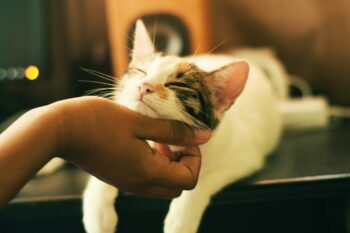Since cats are, after all, a different species than us, their ways of showing pain are also different — but not so different that you can’t learn to recognize when your cat is hurting. Since your cat can’t tell you that her back is bothering her, or that every time she uses the litter box it burns, it’s up to you to know her well enough that you can tell something is wrong.
Pain in your cat can have many causes, including arthritis, urinary tract infections, dental problems, cancer, or even post-operative pain. Sometimes the cause can be as subtle as her symptoms. One cat owner in New York City, Richard O’Russa, noticed that when his rather overweight calico cat jumped off the windowsill, she would stop and sit down abruptly. When she started doing the same thing while walking across the kitchen floor, he decided to take her to the veterinarian. The cause? A luxated patella — a bad knee — was hurting her. The solution? She had to lose weight. After putting her on a strict diet, his kitty is now jumping easily from couch to cat tree.
“Just as in people, a cat’s tolerance to pain varies from individual to individual,” says Drew Weigner, DVM, board-certified feline specialist and a spokesperson for the American Animal Hospital Association. “Some may be more overt than others, but most cats are fairly discreet in showing signs of pain. This is likely a survival instinct, as cats showing overt symptoms of pain would be easy prey in the wild.”
What this means is that you should know your cat’s individual routine well enough to notice when she does something out of the ordinary. Never turned down food before? Then if she only nibbles a little of her breakfast and then spends longer than usual in the litter box, it may indicate that her digestion is not right. Is a normally lazy cat pacing back and forth? Is she licking and biting at a particular area on her body? These are all signs that something may be bothering her.
While every cat is an individual, there are some general signs that can indicate any cat is hurting. “The most common symptoms of pain are hiding and withdrawing from social interaction,” says Weigner. If your normally gregarious cat is crouching tensely in the bedroom with wide-open eyes and enlarged pupils, that’s a signal to call your veterinarian right away.
It is very important NOT to try to treat your cat’s pain by yourself. Many human pain relievers, such as Tylenol, are poisonous to your cat. If your cat’s pain is chronic, or will be present for some time, your veterinarian will devise a pain-management plan especially for her. Some alternative therapies, such as acupuncture or massage, may also help relieve pain. But the most important thing is for you to know your cat well enough that, even without words, she can tell you when it hurts.







